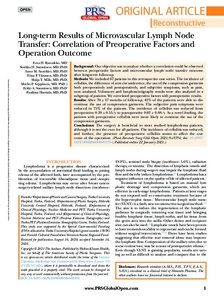Long-term Results of Microvascular Lymph Node Transfer: Correlation of Preoperative Factors and Operation Outcome
Rannikko Eeva H; Seppänen Marko P; Viitanen Tiina P; Suominen Erkki A; Hartiala Pauliina; Saarikko Anne M; Suominen Sinikka H; Mäki Maija T
https://urn.fi/URN:NBN:fi-fe2021093048235
Tiivistelmä
Background: Our objective was to analyze whether a correlation could be observed between preoperative factors and microvascular lymph node transfer outcome after long-term follow-up.
Methods: We included 67 patients in this retrospective case series. The incidence of cellulitis, the difference of arm circumference, the use of the compression garments both preoperatively and postoperatively, and subjective symptoms, such as pain, were analyzed. Volumetry and lymphoscintigraphy results were also analyzed in a subgroup of patients. We correlated preoperative factors with postoperative results.
Results: After 70 +/- 17 months of follow-up, 42% of the patients were able to discontinue the use of compression garments. The subjective pain symptoms were reduced in 75% of the patients. The incidence of cellulitis was reduced from preoperative 0.20 +/- 0.55/y to postoperative 0.02 +/- 0.08/y. As a novel finding, the patients with preoperative cellulitis were more likely to continue the use of the compression garments.
Conclusions: The surgery is beneficial to most studied lymphedema patients, although it is not the cure for all patients. The incidence of cellulitis was reduced, and further, the presence of preoperative cellulitis seems to affect the outcome of the operation.
Kokoelmat
- Rinnakkaistallenteet [19218]
